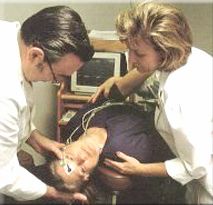 Maniobra terapéutica para el VPPB que se realiza con la cabeza del paciente. Se lleva a cabo colocando la cabeza del paciente en la posición inicial de la prueba de Dix-Hallpike, es decir, hasta la posición de hiperextensión cervical sobre el oído enfermo, para posteriormente ir rotando lentamente la cabeza hacia el oído contrario, después de unos segundos de permanecer en esta posición, el paciente se coloca en decúbito lateral sobre el oído contrario al enfermo, para posteriormente sentarse al borde de la camilla del mismo lado del decúbito lateral, con la cabeza flexionada 30º.
Maniobra terapéutica para el VPPB que se realiza con la cabeza del paciente. Se lleva a cabo colocando la cabeza del paciente en la posición inicial de la prueba de Dix-Hallpike, es decir, hasta la posición de hiperextensión cervical sobre el oído enfermo, para posteriormente ir rotando lentamente la cabeza hacia el oído contrario, después de unos segundos de permanecer en esta posición, el paciente se coloca en decúbito lateral sobre el oído contrario al enfermo, para posteriormente sentarse al borde de la camilla del mismo lado del decúbito lateral, con la cabeza flexionada 30º. <(A): Epley-Manöver: Kanalrepositionsverfahren: dienen der Behandlung des benignen paroxysmalen Positionsschwindes (BPPV) durch induzierte Ausmigration frei beweglicher pathologischer Dichten in der Endolymphe eines halbkreisförmigen Kanals unter Verwendung von zeitgesteuerten Kopfmanövern und angewandter Vibration.
<(F): Manoeuvre de Epley: consiste à étendre le sujet sa tete tournée du coté déclencheur du vertige. Ensuite apres un moment de repos, on tourne doucement la tete de 90° vers le coté controlatéral. Il ne se produit pas de vertige. On replace alors le patient en position assise et l'inertie du mouvement amene les débris otolithiques en face de la crus commune et ils retombent dans le vestibule ou en principe ils seront réabsorbés au niveau des cellules sombres.
<(Ing): Epley maneuver; canalith repositioning procedure: are designed to treat benign paroxysmal positional vertigo (BPPV) through induced out-migration of free-moving pathological densities in the endolymph of a semicircular canal, using timed head maneuvers and applied vibration.
BUSCADORES EN CIENCIAS DE LA SALUD.
- BING. <(E)
- GOOGLE ACADEMICO. <(E)
- GOOGLE SCHOLAR. <(Ing)
- HON: Health On the Net oundation. <(Ing)
- MEDNAR (WEB INVISIBLE).< (Multilingüe)
- SCIENCE.GOV: U.S. FEDERAL SCIENCE.< (Ing)
- STARPAGE.COM. <(E)
- YAHOO. <(E)
- YIPPY <(E)
FUENTES DE INFORMACIÓN BIOMÉDICA:
- BIBLIOTECA VIRTUAL DE SAUDADE. <(E) - <(P) - <(Ing)
- CISMeF - outil de recherche en santé. <(F)
- LA BIBLIOTECA COCHRANE PLUS. <(E)
- MEDIGRAPHIC – LIERATURA BIOMÉDICA. <(E)
- NATIONAL LIBRARY OF MEDICINE: Biotechnology Information. <(Ing)
- PubMed. <(Ing)
- SCIENCE DIRECT ®. <(Ing)
- TRIP MEDICAL DATABASE. < (Ing)
LIBROS.
- GOOGLE BOOKS.<(Multilingüe)
- ELSEVIER.<(Multilingúe
- SPRINGER. (Ing)
SLIDE / FOTOS:
- SLIDESAHARES. <(Multilingüe)
VIDEOS:
TÉRMINOS RELACIONADOS:
